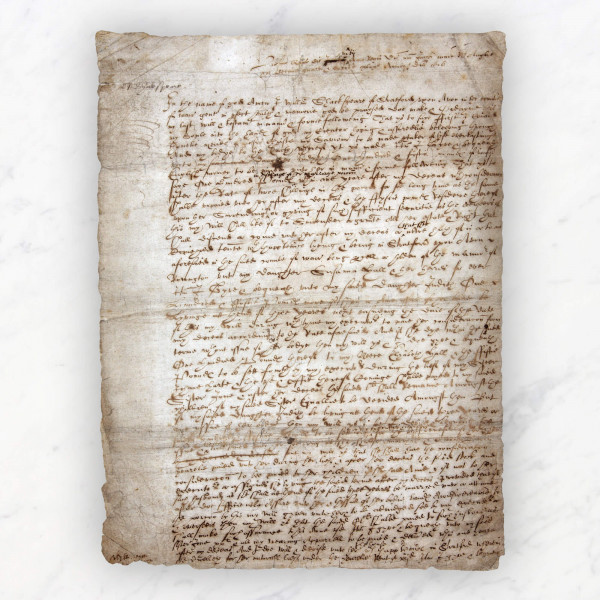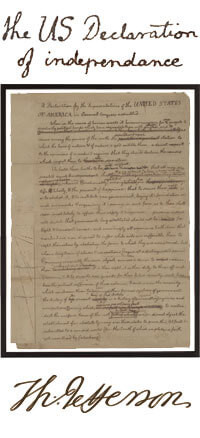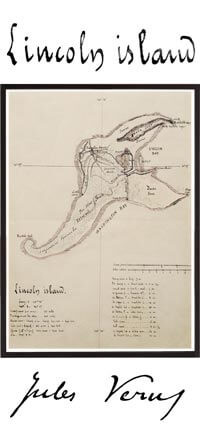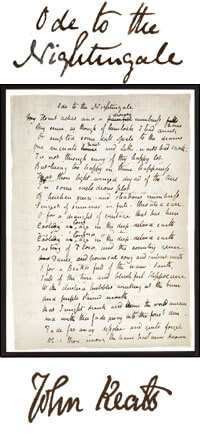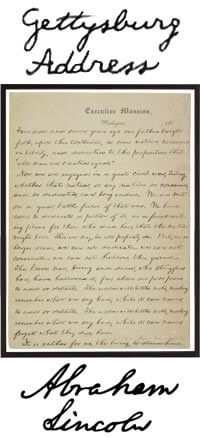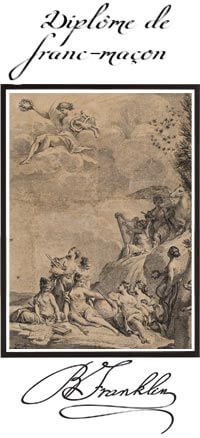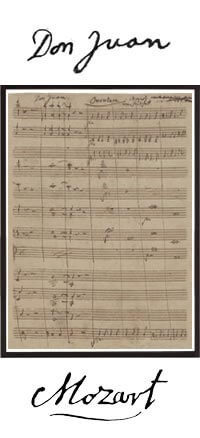Last Will & Testament by William Shakespeare
Shakespeare's Last Will & Testament
handwritten by William Shakespeare.
Double-sided document
Double-glass framing
23" x 17" frame
3 handwritten pages
A unique manuscript, presented in three frames
In honor of the 400 year anniversary of William Shakespeare’s death, Editions des Saints Peres presents a framed reproduction of this unique document.
One would expect that history’s most prolific playwright, author of 37 plays and 150-some sonnets, would have left behind a few manuscripts, literary or personal. However all that is left are six signatures, three of which can be found in this document.
The testament, preciously conserved at the National Archives in London, was most likely completed in several stages –- first drafted by Shakespeare’s lawyer Francis Collins in January 1616, then expanded upon with several significant insertions in dark ink just a few weeks before his death 23 April 1616. Furthermore, a recent X-ray and near infrared light study conducted by the National Archives revealed that the second page was actually written in 1613, 3 years before the other two pages.
What the manuscript tells us about Shakespeare
The document reveals Shakespeare as a savvy businessman, as well as a responsible husband and father who kept his will up to date in order to ensure his family’s financial security after his death.
He meticulously allocates the majority of his goods to his daughters (with an evident preference for Susannah Hall, his oldest child), leaving nothing up to fate, bequeathing all of his possessions down to a silver bowl, a sword, and most famously, his 'second best bed' to his wife Anne.
The document puts certain common theories about the author’s life into perspective. For example, Shakespeare, weary about his son-in-law Thomas Quiney, bars him out of the will. Also Shakespeare, indifferent towards his wife, bequeaths her only the 'second best bed' of the house.
It turns out that the manuscript, written in a rather conventional legal language for the 17th century, is not as cold as if may appear to the modern reader. It is the testimony of a genius during his last moments of life.
The controversy
The absence of manuscript traces from Shakespeare’s work has long raised questions and suspicion about his work’s authorship, and the man himself. This Testament and Will divides experts, and unleashes passion. Why no mention of his manuscripts, his work, or his shares at the London Theatre? He does however allocate a special sum for his actor friends to buy memorial rings…
Double-sided document presented in a double-glass framing (13 x 17").
Wooden frame, made in France. Each frame is hand-assembled in our workshops in Cambremer.
Mrs Dalloway: Thanks to a new reproduction of the only full draft of Mrs. Dalloway, handwritten in three notebooks and initially titled “The Hours,” we now know that the story she completed — about a day in the life of a London housewife planning a dinner party — was a far cry from the one she’d set out to write (...)
The Grapes of Wrath: The handwritten manuscript of John Steinbeck’s masterpiece The Grapes of Wrath, complete with the swearwords excised from the published novel and revealing the urgency with which the author wrote, is to be published for the first time. There are scarcely any crossings-out or rewrites in the manuscript, although the original shows how publisher Viking Press edited out Steinbeck’s dozen uses of the word “fuck”, in an attempt to make the novel less controversial. (...)
Jane Eyre: This is a book for passionate people who are willing to discover Jane Eyre and Charlotte Brontë's work in a new way. Brontë's prose is clear, with only occasional modifications. She sometimes strikes out words, proposes others, circles a sentence she doesn't like and replaces it with another carefully crafted option. (...)
The Jungle Book: Some 173 sheets bearing Kipling’s elegant handwriting, and about a dozen drawings in black ink, offer insights into his creative process. The drawings were not published because they are unfinished, essentially works in progress. (...)
The Lost World: SP Books has published a new edition of The Lost World, Conan Doyle’s 1912 landmark adventure story. It reproduces Conan Doyle’s original manuscript for the first time, and includes a foreword by Jon Lellenberg: "It was very exciting to see, page by page, the creation of Conan Doyle’s story. To see the mind of the man as he wrote it". Among Conan Doyle’s archive, Lellenberg made an extraordinary discovery – a stash of photographs of the writer and his friends dressed as characters from the novel, with Conan Doyle taking the part of its combustible hero, Professor Challenger. (...)
Frankenstein: There is understandably a burst of activity surrounding the book’s 200th anniversary. The original, 1818 edition has been reissued, as paperback by Penguin Classics. There’s a beautifully illustrated hardcover, “The New Annotated Frankenstein” (Liveright) and a spectacular limited edition luxury facsimile by SP Books of the original manuscript in Shelley's own handwriting based on her notebooks. (...)
The Great Gatsby: But what if you require a big sumptuous volume to place under the tree? You won’t find anything more breathtaking than SP Books ’s facsimile of F. Scott Fitzgerald’s handwritten manuscript of The Great Gatsby, showing the deletions, emendations and reworked passages that eventually produced an American masterpiece (...)
Oliver Twist: In the first ever facsimile edition of the manuscript SP Books celebrates this iconic tale, revealing largely unseen edits that shed new light on the narrative of the story and on Dickens’s personality. Heavy lines blocking out text are intermixed with painterly arabesque annotations, while some characters' names are changed, including Oliver’s aunt Rose who was originally called Emily. The manuscript also provides insight into how Dickens censored his text, evident in the repeated attempts to curb his tendency towards over-emphasis and the use of violent language, particularly in moderating Bill Sikes’s brutality to Nancy. (...)
Peter Pan: It is the manuscript of the latter, one of the jewels of the Berg Collection in the New York Public Library, which is reproduced here for the first time. Peter’s adventures in Neverland, described in Barrie’s small neat handwriting, are brought to life by the evocative color plates with which the artist Gwynedd Hudson decorated one of the last editions to be published in Barrie’s lifetime. (...)






